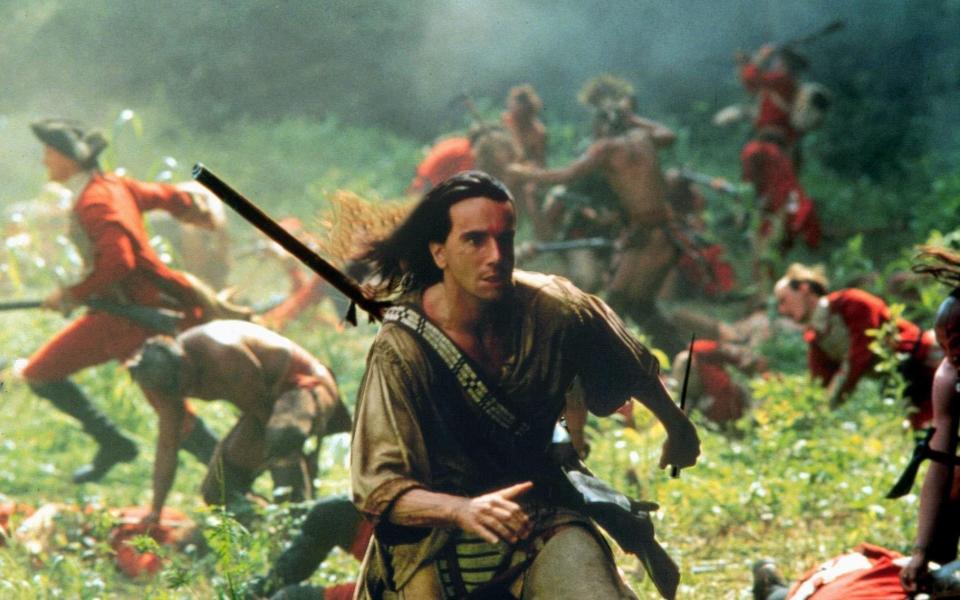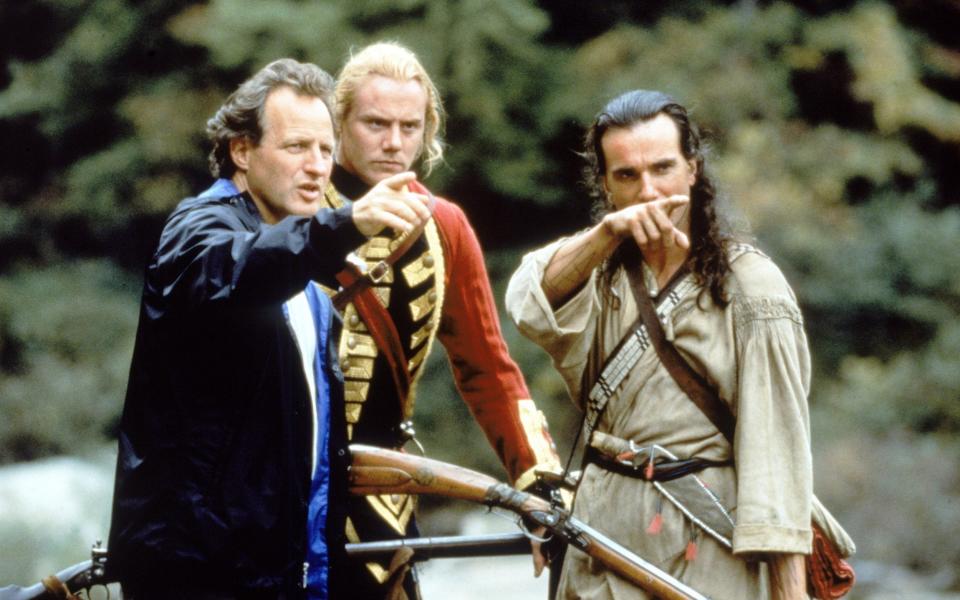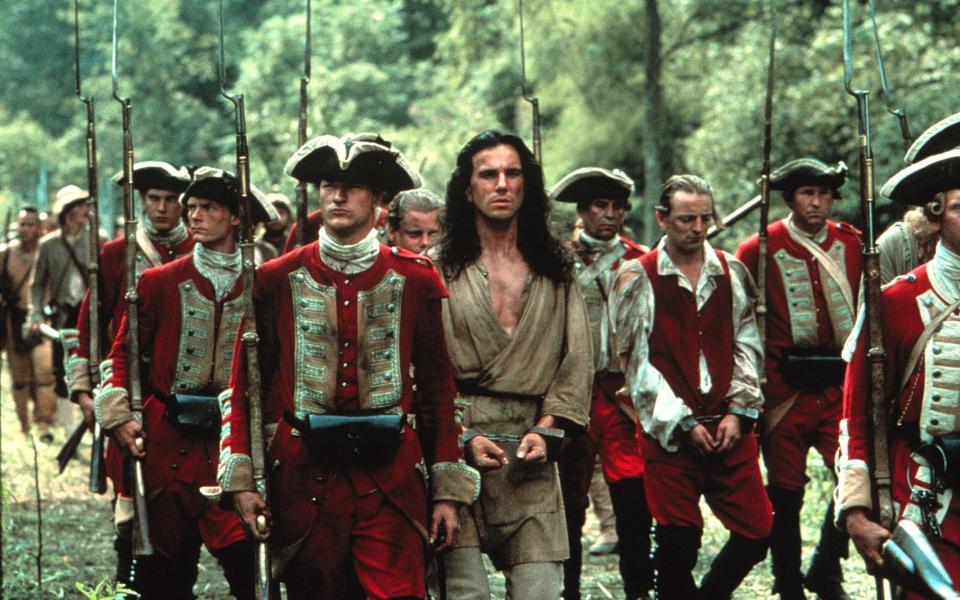How ‘appallingly violent’ The Last of the Mohicans sent Daniel Day-Lewis over the edge

In late 1991, Daniel Day-Lewis was standing thigh-deep in freezing water, in the remote Blue Ridge Mountains of North Carolina. Most Oscar-winning A-list stars would have sent their stand-in to suffer such torment, or simply refused to put up with the indignity altogether.
But Day-Lewis, who was then filming adventure epic The Last of the Mohicans – which celebrates its 30th anniversary this month – with the director Michael Mann, had entirely committed to the experience, which would last up to 15 minutes at a time. He remained in character as Nathaniel Poe, aka “Hawkeye”, no matter what the circumstances demanded. This dedication to realism, coupled with an uncompromising and obsessive filmmaker, would push Day-Lewis further than ever before.
At the beginning of the Nineties, there were few actors more sought-after for prestigious projects. My Left Foot had won him an Oscar for Best Actor in 1990 for portraying the wheelchair-bound cerebral palsy sufferer Christy Brown who learned to communicate with the world with his left foot. The all-action role that he now undertook could not have been a greater shift.
However, even at this stage in Day-Lewis’s career, there were murmurings that his brilliance as an actor was only equalled by an intensity and commitment to his craft that could become all-consuming. While he was playing Brown, he remained in a wheelchair throughout production, refusing to do anything that the character he was portraying could not do, which meant that production staff had to carry him around and feed him.
When he played Hamlet on stage at the National Theatre in 1989, he reportedly saw the ghost of his own father, the poet Cecil Day-Lewis, on stage, and left the run early after breaking down. Although he had received kudos for the wild eclecticism of the roles that he had played since his dual breakthrough in 1985 with his portrayals of, respectably, a stuffy Edwardian fop in A Room With A View and a gay street punk in My Beautiful Launderette, there was also the question being asked: is Day-Lewis going to last?
After a period away from both the cinema and the stage (the latter of which he never returned to), Day-Lewis considered his options at the beginning of the Nineties. On the one hand, he was an Oscar-winning actor of peerless talent, but on the other, he was seen almost as a liability. He commented that, after his Hamlet breakdown, “I touched upon the fringes of analysis. There was a period when I needed to talk to somebody – when I was made to talk to somebody because the National Theatre needed to fill in their insurance forms. It was very helpful. I’ve always had a bloody-minded attitude toward feeling poorly. I was saved from choosing the darker avenue, which is always my preferred choice. I was encouraged to believe that I wasn’t inherently demonic.”
The result of this therapy was, in part, to encourage him to pursue a new challenge. The epic action-adventure film that Michael Mann – then best known for creating the cult Eighties show Miami Vice, and for directing the first Hannibal Lecter film, Manhunter – had in mind would stretch Day-Lewis both physically and mentally. Mann’s script was based on James Fenimore Cooper’s 1826 novel, which, by the early Nineties, was more cited than read.
Not only did its protagonist have the less-than-heroic name of Natty Bumppo, but, as Mark Twain quipped, “In the restricted space of two-thirds of a page, Cooper has scored 114 offenses against literary art out of a possible 115.” The filmmaker dismissed it as “not a very good book…almost a justification for a massive land grab”, noting that the author had enormous real estate holdings in the areas that he wrote about and remained pro-colonialist.

This had to change. Mann, a director whose entire career has been based on his alpha-male protagonists pushing themselves to their limits, and beyond, instead described the project as “a love story based in a war zone”, and took the original storyline in very different directions. He foregrounded the romance between Day-Lewis’s character Hawkeye, a child of white parents adopted by Native Americans, and Madeline Stowe’s Cora Munro, the privileged daughter of an army colonel. And used his film to offer a critique of colonialism in the 1757 French and Indian War.
This was no sprawling, decades-spanning epic, but a tightly packed character drama that took place over a fortnight. As Mann said: “The whole thing happens in two weeks—two weeks totally packed with conflict. [It is] thrilling history, something like the spring of 1968. France and England are fighting what was really the first World War, and each nation is allied to a different native American tribe. Plus, after 150 years of white immigration, the Indians decide their deal with the white man has reached critical mass.”
It was different territory for both Mann and Day-Lewis, but the actor was attracted to the role because of Mann’s description of Hawkeye as “the man with the new music”; in other words, a product of two contradictory environments, both Indian and European, and able to represent a new kind of American. This was not the Randolph Scott or John Wayne incarnation of a Western hero, but something altogether more contemporary. He said: “This was the moment just before land-hunger. Just before the pushing-inward of native tribes had really begun. This was a time when, just for a moment, people knew how to live with each other. They knew the human politics of it, the day-to-day language of coexistence.”

It was not without self-knowledge that Day-Lewis, commenting on the relationship between Hawkeye and his Indian brother Uncas, stated: “The frontier hero has always been thought of as an existential loner, some guy who lives just to exert himself in war. But the real roots of that warrior image are profoundly different. The native American warrior used his strength to serve his family, his tribe and the life of his nation.”
He also liked the concept of the film’s opening scene, where Hawkeye participates in an elk hunt; in its brutal physicality, it could not have been more different to his earlier roles, but also gave the actor the chance to embrace a kind of rough, highly physical therapy. He said: “I liked the idea of a man who had not been touched by 20th-century neurosis…a life that isn’t drawn inwards.” Mann, meanwhile, praised his star as “immensely concentrated, and fearless…he will do and try anything.”
After the enormous, Oscar-winning success of Kevin Costner’s Dances with Wolves, studios were keen to produce another film that had a similar mixture of epic adventure and social understanding, far removed from the old clichés of cowboy-and-Indian films. Mann was given a $40 million budget (raised from an initial $33 million) and approached the project with his usual, near-Kubrickian dedication to realism. All the Native American actors cast in the film were recruited from their own historical tribes, with the vast majority Iroquois-speaking groups from New York State.
The relationship between Hollywood and indigenous Indians had often been a troubled one, rife with condescension on the one side and resentment on the other. Memories were still fresh of the Native American civil rights activist Sacheen Littlefeather delivering a speech at the 1973 Oscars ceremony, in which she refused Best Actor on Marlon Brando’s behalf for “the treatment of Native Americans in the film industry” – something that infuriated John Wayne so much that he had to be stopped from attacking her – and Mann was determined not to make these mistakes again.

He took particular care with the film’s antagonist Magua, as played by Wes Studi, to portray him as three-dimensional and possessed of a genuine grievance. He said: “He happens to be the only one who properly analyzes the politics. The American Indians are in an existential crisis.” He also cast the Native American activist Russell Means in the key role of Chingachgook, Hawkeye’s adopted father. Means, who had not acted before, later praised Mann as “a genius”, but castigated the assistant directors as “very difficult human beings” and given to casual racism, referring to the Native American actors simply as “Indians” on set; a staunch intervention from Means – pointedly referring to “white people” in the same dismissive tone – led to a greater mutual understanding.
With the script satisfactory, Mann recreated the central location of Fort William Henry from original 18th-century building plans, and went to painstaking lengths to ensure that all the props featured, from tomahawks to rifles, were as authentic as they possibly could be. Yet the film’s obscure filming locations in North Carolina were freezing cold and near-impossible to reach, leading to resentment from the actors and, at one point, a strike from the Native American extras, who felt that they were being treated poorly, and successfully lobbied for higher pay. Mann said: “Making The Last of the Mohicans was particularly challenging. We were trying to re-create the conditions, the tones, the value systems of 1757, particularly for somebody raised in an Algonquian-speaking tribal group such as the Mohicans.”
A combination of Mann’s perfectionism and the difficulties of location shooting led to him firing both the film’s original costume designer, James Acheson, and the first cinematographer, Kubrick collaborator Douglas Milsome, the latter of whom was replaced by Mann’s regular director of photographer Dante Spinotti. The new cinematographer was far more receptive to Mann’s pioneering desire to shoot with natural light as far as possible, nodding both to Kubrick’s similarly-set Barry Lyndon and anticipating Alejandro González Iñárritu’s The Revenant. Spinotti said: “What else would you want from life than a chance to film a great story set in 1700? Michael’s visual references included a couple of paintings, including Thomas Cole and Alfred Bierstadt. This is very typical of Michael. He shows you a simple image and says, ‘This is the movie.’ The paintings all showed how small human beings are in the scope of nature. Michael wanted everything to be extremely accurate.”

Yet if the director was a hard taskmaster, his leading man relished the challenges that he was faced with. Day-Lewis worked with a fitness trainer five times a week for six months to develop the physicality that the character would have needed, and then spent a month in the North Carolina woods, essentially living wild, in order to understand the life of an American Indian. (As his trainer said, in perhaps the understatement of the decade: “He’s extremely keen to get things right”.)
He described eating “vast amounts of food…which, for me, was a difficult thing”, and worked with Colonel David Webster, a Special Forces former soldier who taught pilots survival skills for if they were shot down. Mann said, with some relish, to Webster of his leading man: “He’s the son of a poet [who’s] never fired a weapon…I need you to give him the skills that a person would have had in that period, as an outdoorsman and a frontiersman.”
The actor visited the Many Hawks Special Operations Center with Webster, where he was taught how to use weapons of all kinds, from contemporary assault rifles to more period-specific equipment. He then underwent an intensive crash course in the skills that a survivalist would have needed, and became an expert at anything from tracking and skinning animals to fighting with tomahawks. One person who he worked with, Benton Jennings, was especially useful; Day-Lewis subsequently said of him: “He basically lives in the 18th century – way beyond being a re-enactor – and he knew everything about trapping, fire-building, skinning animals and cooking.”
Under Webster and Jennings’ tutelage, Day-Lewis became adept at the skills that any frontiersman would have developed during the period. The actor was particularly attached to a 12-pound flintlock rifle, which never left his side – as it would not have left his character’s – up to and including its being present at his Christmas dinner while filming. We do not, alas, have any accounts of how his friends and family felt about the actor coming to the celebration fully armed.
The four-month shoot was an extraordinarily gruelling one. Day-Lewis once again never broke character while filming, and, towards the end of filming, Day-Lewis barely ate or slept, partly because of the film’s increasingly difficult prolonged shooting schedule, and also because, as Mann quipped: “If he didn’t shoot it, he didn’t eat it”. The actor later commented to a journalist that he had suffered “slight hallucinations” and said: “I find it difficult to be in rooms now for long periods of time. I can usually take it for about an hour. Then I stride out.”
His co-star Stowe found it a similarly difficult experience, and later said: “The shoot was so difficult on the crew and the extras. Often, it was unpleasant for them and many left. But difficulty also creates its own kind of beauty, I suppose.” Her mood was lightened on set by what she called “trying to do the silliest things when we weren’t rolling cameras, anything to lift the spirits.”

An exhausted Day-Lewis joined her in these blackly comic jokes, which began with food fights and escalated to a recreation of a road accident, complete with bloodied victim, staged by Day-Lewis and his driver, something that the actor apologised for by saying: “The location drove us to it.” Yet he remained a calm and controlled presence on set. Stowe said: “I tried to goad him into getting angry and he wouldn’t. It drove me crazy.” Nonetheless, she praised him on a personal level, saying: “You never feel him engaging in a battle of wills. He doesn’t have an intrusive bone in his body.”
Upon the film’s release, it was marketed as a big-budget action-adventure film, rather than the prestigious literary adaptations that Day-Lewis had more closely been associated with up until then. There had been some difficulties in early test screenings – as Stowe said, “audiences were appalled at the violence” – but Mann insisted that the film was released uncut, and 20th Century Fox, the studio behind the picture, eventually agreed.
The posters featured an intense shot of the leading man, with the tagline “The First American Hero”, and the film opened to decent – if not outstanding – box office results and ecstatic reviews from critics, who praised it as a cerebral and thrilling experience and singled out Day-Lewis’s performance for particular praise. He was nominated for a Bafta for Best Actor (losing to Robert Downey Jr in Chaplin) and the experience gave him back his interest in screen acting: his next role, in Martin Scorsese’s The Age of Innocence, came almost immediately after, and could not have been more different in its precise restraint.
Mann, of course, went on to become one of Hollywood’s premier directors of intense action films, some of which – Heat, Collateral – are regarded as classics, and others of which – Blackhat, anyone? – have met with less laudatory responses. But although Day-Lewis undertook other intensely physical roles throughout the rest of his career, such as the IRA pugilist Danny Flynn in 1997’s The Boxer and Daniel Plainview in There Will Be Blood, he never again took on the mantle of the heroic leading man.
When, shortly before the release of The Last of the Mohicans, he was asked by the New York Times whether he was preparing for a new career as a Hollywood action hero, his response was both surprised and pained. “In almost every respect, I’d say no. I don’t deal at all well with the relative amount of stuff I have to face already. I don’t want to think about it because it only depresses me.”
This refusal to be pigeonholed has suited this most restless of actors perfectly. As he said to The Independent in 2006: “I do so love the pure joy of learning something new. I’m sure I could arrive at the same effect for any given role in just two weeks, but I choose not to.” As The Last of the Mohicans proved, this was to both his – and cinema’s – great benefit.

 Yahoo Movies
Yahoo Movies 